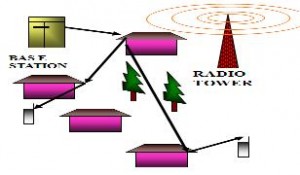Survey of Radio Propagation Models for Mobile Communication objective is to design a receiver that is suitable and will receive the signal that is transmitted and distorted because of the effects of channel dispersion and multipath that will easily decode the signal that is transmitted. The propagation models can address the problems in actual.
There are four kinds of fading like:
Flat-fading
Slow and fast fading
Selective fading
Large-scale fading
There are again several basic propagation mechanisms like:
Scattering
Diffraction
Reflection
The Ray – tracing technique is based on the geometrical optics. The principle of the local fields and Fermat are the basic two concepts that are used extensively by the models. As per the principle of the Fermat the ray only allows the shortest distance from the field point to a source point. As per the principle of the local fields the high – frequency rays always produce reflection, destruction and refraction especially when it is hitting a hard surface. Image method and brute force ray tracing methods are the two kinds of ray-tracing methods.
The image methods help to generate the images on a plane from a source. These images further serve the purpose of secondary source for the points and reflections. It is only advisable for simple environments. Usually rays over the rooftops and reflections on the grounds are neglected. As per the order and number of reflections in diffraction rays that are considered a threshold must be set.
The Bruce-force ray- tracing method includes a heap of rays that are a transmitted or may not able to reach the receiver. The possible direction of the propagation from the transmitted is opted for a finite sample. For each of the directions a ray is launched. To obtain the rays from the source point there are two methods – 2D and 3D approach of ray tracing. A node is used for representing a surface interaction of an object.
Download Survey of Radio Propagation Models for Mobile Communication PPT

